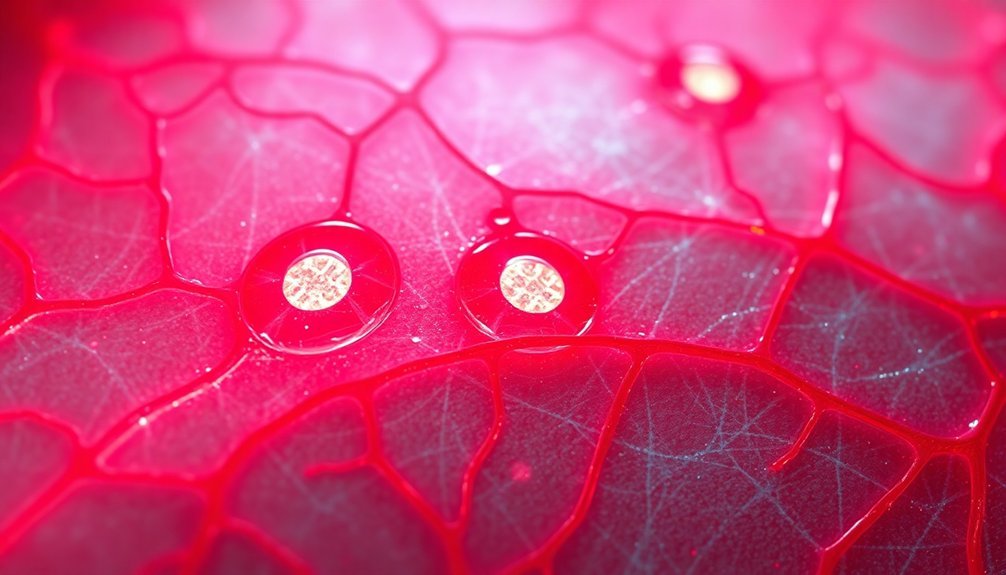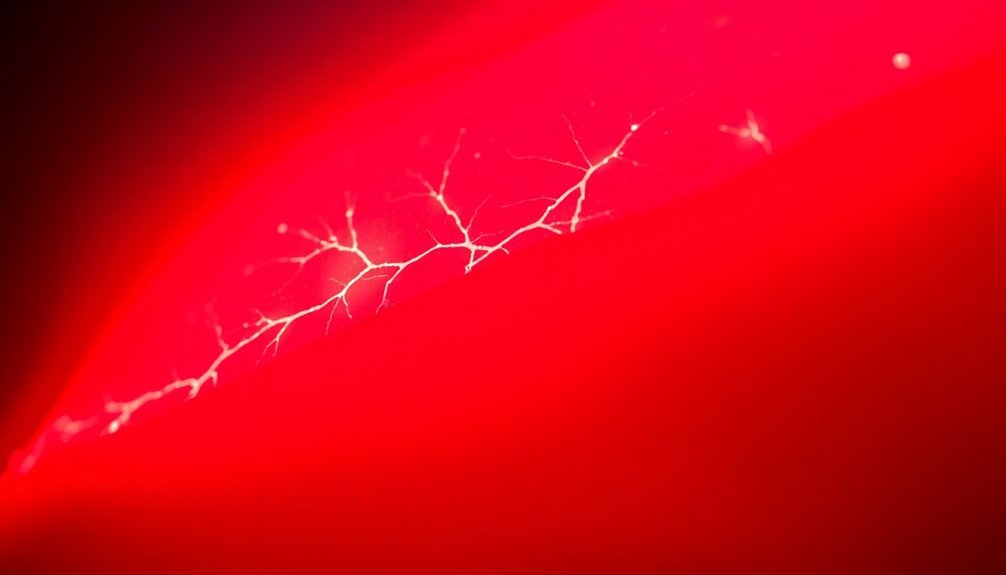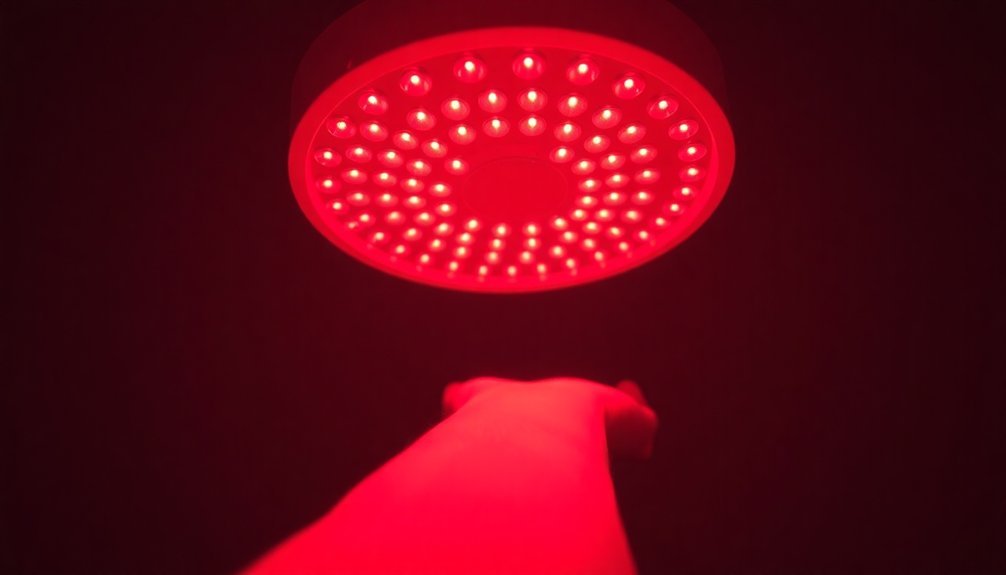Red light therapy speeds up your wound healing through three powerful mechanisms. First, it boosts your cellular energy production by stimulating mitochondria to create more ATP, giving cells the fuel they need to repair damage. Second, it promotes the formation of new blood vessels through angiogenesis, ensuring wounded areas receive essential oxygen and nutrients. Third, it activates fibroblasts to increase collagen production, which helps rebuild and strengthen damaged tissue. These three processes work together to accelerate your body's natural healing abilities, and there's even more to discover about this fascinating therapeutic approach.
Cellular Energy Production Boost

Energy powerhouses within your cells spring into action when exposed to red light therapy. Your mitochondria, the tiny structures responsible for producing cellular energy, become more efficient and productive when stimulated by red light.
This boost in mitochondrial function directly increases your cells' ATP production, which is essential for powering healing processes. Sustained ATP levels prevent muscle weakness and fatigue during recovery.
When red light penetrates your tissue, it enhances your cells' electron transport chain, making cellular respiration more effective. You'll get more energy from the same amount of resources, as the therapy helps clear nitric oxide that can block energy production.
What's more, red light therapy can actually increase the number of mitochondria in your cells, creating even more energy-producing capacity.
You'll also benefit from reduced oxidative stress, as the therapy boosts your antioxidant enzyme activity while decreasing harmful reactive oxygen species (ROS). This protection helps maintain your cellular machinery in better condition, allowing for sustained energy production.
The overall improvement in cellular energy metabolism means your cells can function at their peak, supporting various healing processes and tissue repair mechanisms.
Enhanced Blood Vessel Formation
Red light therapy consistently promotes the formation of new blood vessels through a process called angiogenesis. When you receive red light treatment, particularly at 650 nm wavelength, it stimulates your endothelial cells to produce vascular endothelial growth factor (VEGF) and form new capillary-like structures. This process is more efficient with red light compared to near-infrared wavelengths of 808 nm.
The therapy works by triggering several key mechanisms in your body. It increases the flow of extracellular calcium, advances cell cycle progression, and boosts nitric oxide generation in endothelial cells. You'll also see an increase in M2 macrophages under low-oxygen conditions, which is essential for proper wound healing. The increased cellular energy production stimulates ATP production in the mitochondria, further supporting the healing process.
What's particularly beneficial is the vasodilatory effect you'll experience. When you're exposed to red light at 670 nm, your blood flow increases and remains elevated for at least 30 minutes after treatment. The best results come from 5-10 minutes of exposure at 50 mW/cm2. This enhanced blood vessel formation leads to faster wound healing, stronger tissue repair, and improved surgical recovery with less pain.
Collagen Stimulation Response

While enhanced blood vessel formation supports healing from the outside in, the stimulation of collagen production works at a deeper cellular level. When red light penetrates your skin, it triggers a remarkable chain of events within your cells, particularly in the mitochondria – your cellular powerhouses.
You'll find that red light therapy kickstarts ATP production, which is essential for powering your cells' healing activities. This boost in cellular energy activates fibroblasts, the specialized cells responsible for producing collagen. As your fibroblasts become more energized, they ramp up collagen synthesis, strengthening the healing tissue. The process restores declining collagen levels that naturally occur as aging reduces production.
Clinical studies have shown that you can expect significant improvements in wound healing when you undergo red light therapy. The increased collagen production doesn't just help close wounds – it also improves the quality of healing tissue. You'll notice better skin texture and enhanced firmness in the treated areas.
What makes this process particularly effective is that it works at multiple levels. While stimulating collagen production, red light therapy also influences gene expression related to healing and enhances cellular respiration.
These combined effects create an ideal environment for wound recovery, leading to faster and more efficient healing.
Frequently Asked Questions
How Long Should Each Red Light Therapy Session Last for Optimal Wound Healing?
You'll want to keep your red light therapy sessions between 10-20 minutes per treatment area. If you're using high-intensity light, reduce it to 1-5 minutes, while medium-intensity requires 5-10 minutes.
Can Red Light Therapy Be Combined With Other Wound Treatments?
Yes, you can safely combine red light therapy with other wound treatments. It'll enhance healing when used alongside antibiotics and standard wound care, leading to faster recovery and better collagen production.
What Wavelengths of Red Light Are Most Effective for Wound Healing?
You'll find the most effective wavelengths for wound healing are between 600-700 nm for red light, with 660 nm being particularly effective. Near-infrared wavelengths of 770-1200 nm, especially 890 nm, also work well.
Does Red Light Therapy Work on Infected Wounds?
Yes, red light therapy can effectively treat your infected wounds. It'll reduce bacterial loads, enhance healing, and manage inflammation. You'll see better results when it's combined with standard wound care treatments.
How Soon After Injury Should Red Light Therapy Treatment Begin?
You should start red light therapy as soon as possible after injury, ideally within the first 24-48 hours. It'll help manage inflammation immediately, though you'll need to adjust treatment duration based on your wound's condition.
In Summary
You'll find that red light therapy offers multiple pathways to faster healing. By ramping up your cells' energy production, encouraging new blood vessel growth, and stimulating collagen formation, you're giving your body powerful tools for wound recovery. Whether you're dealing with a minor cut or recovering from surgery, these red rays can help you heal more efficiently and get back to your normal activities sooner.





Leave a Reply